Events & Promotions
|
|

GMAT Club Daily Prep
Thank you for using the timer - this advanced tool can estimate your performance and suggest more practice questions. We have subscribed you to Daily Prep Questions via email.
Customized
for You
Track
Your Progress
Practice
Pays
Not interested in getting valuable practice questions and articles delivered to your email? No problem, unsubscribe here.
- Nov 20
07:30 AM PST
-08:30 AM PST
Learn what truly sets the UC Riverside MBA apart and how it helps in your professional growth - Nov 22
11:00 AM IST
-01:00 PM IST
Do RC/MSR passages scare you? e-GMAT is conducting a masterclass to help you learn – Learn effective reading strategies Tackle difficult RC & MSR with confidence Excel in timed test environment - Nov 23
11:00 AM IST
-01:00 PM IST
Attend this free GMAT Algebra Webinar and learn how to master the most challenging Inequalities and Absolute Value problems with ease. - Nov 25
10:00 AM EST
-11:00 AM EST
Prefer video-based learning? The Target Test Prep OnDemand course is a one-of-a-kind video masterclass featuring 400 hours of lecture-style teaching by Scott Woodbury-Stewart, founder of Target Test Prep and one of the most accomplished GMAT instructors.
Kudos
Bookmarks
Question 1
E
Be sure to select an answer first to save it in the Error Log before revealing the correct answer (OA)!
Difficulty:
 45%
(medium)
45%
(medium)
Question Stats:
61% (02:43) correct 39%
(02:35) wrong
39%
(02:35) wrong  based on 880
sessions
based on 880
sessions
History
Date
Time
Result
Not Attempted Yet
Question 2
A
Be sure to select an answer first to save it in the Error Log before revealing the correct answer (OA)!
Difficulty:
 5%
(low)
5%
(low)
Question Stats:
86% (00:35) correct 14%
(00:46) wrong
14%
(00:46) wrong  based on 845
sessions
based on 845
sessions
History
Date
Time
Result
Not Attempted Yet
Question 3
C
Be sure to select an answer first to save it in the Error Log before revealing the correct answer (OA)!
Difficulty:
 45%
(medium)
45%
(medium)
Question Stats:
66% (01:26) correct 34%
(01:37) wrong
34%
(01:37) wrong  based on 865
sessions
based on 865
sessions
History
Date
Time
Result
Not Attempted Yet
Question 4
B
Be sure to select an answer first to save it in the Error Log before revealing the correct answer (OA)!
Difficulty:
 35%
(medium)
35%
(medium)
Question Stats:
71% (01:25) correct 29%
(01:31) wrong
29%
(01:31) wrong  based on 638
sessions
based on 638
sessions
History
Date
Time
Result
Not Attempted Yet
Question 5
C
Be sure to select an answer first to save it in the Error Log before revealing the correct answer (OA)!
Difficulty:
 5%
(low)
5%
(low)
Question Stats:
91% (00:34) correct 9%
(00:40) wrong
9%
(00:40) wrong  based on 85
sessions
based on 85
sessions
History
Date
Time
Result
Not Attempted Yet
Question 6
E
Be sure to select an answer first to save it in the Error Log before revealing the correct answer (OA)!
Difficulty:
 15%
(low)
15%
(low)
Question Stats:
84% (01:16) correct 16%
(01:22) wrong
16%
(01:22) wrong  based on 86
sessions
based on 86
sessions
History
Date
Time
Result
Not Attempted Yet
Studies have found that most consumers undertake little prepurchase research into durable goods (goods that are typically used repeatedly over a period of years) and do even less price- comparison shopping, despite the reported importance of price to consumers’ purchase decisions. In view of this finding, it is interesting that studies have documented considerable price variation for durable goods within local markets. Moreover, prices of more expensive durable items tend to exhibit the greatest price variation from store to store.
Why does consumers’ willingness to engage in price-comparison shopping not increase concomitantly with price variation of durable goods? One potential explanation is that consumers simply underestimate the potential savings from comparison shopping and undertake less comparison shopping than expected. A second possible explanation builds upon Thaler’s transaction utility theory, which suggests that the psychological utility that a consumer derives from saving a fixed amount of money, say $20, is inversely related to the price of the item. For example, a consumer may spend more time comparison shopping for a $100 microwave oven than for a $400 television, even though the consumer expects to find a $20 savings in either case; the explanation for this behavior appears to be that the relative savings seem dramatically higher for the microwave than for the television.
Why does consumers’ willingness to engage in price-comparison shopping not increase concomitantly with price variation of durable goods? One potential explanation is that consumers simply underestimate the potential savings from comparison shopping and undertake less comparison shopping than expected. A second possible explanation builds upon Thaler’s transaction utility theory, which suggests that the psychological utility that a consumer derives from saving a fixed amount of money, say $20, is inversely related to the price of the item. For example, a consumer may spend more time comparison shopping for a $100 microwave oven than for a $400 television, even though the consumer expects to find a $20 savings in either case; the explanation for this behavior appears to be that the relative savings seem dramatically higher for the microwave than for the television.
1. The passage suggests that which of the following is true of prices of durable goods?
A. Durable goods tend to exhibit greater price variation at the local level than they do at the regional or national level.
B. Durable goods tend to exhibit more price variation from store to store than do other types of consumer goods.
C. Durable goods tend to exhibit less price variation from store to store than do other types of consumer goods.
D. The prices set by manufacturers of durable goods reflect the fact that those manufacturers are aware that consumers are unlikely to comparison shop.
E. Consumers willing to comparison shop are more likely to discover greater price variations on relatively expensive durable goods than on lower-priced durable goods.
A. Durable goods tend to exhibit greater price variation at the local level than they do at the regional or national level.
B. Durable goods tend to exhibit more price variation from store to store than do other types of consumer goods.
C. Durable goods tend to exhibit less price variation from store to store than do other types of consumer goods.
D. The prices set by manufacturers of durable goods reflect the fact that those manufacturers are aware that consumers are unlikely to comparison shop.
E. Consumers willing to comparison shop are more likely to discover greater price variations on relatively expensive durable goods than on lower-priced durable goods.
2. The primary purpose of the passage is to
A. consider possible explanations for a certain phenomenon
B. recommend a new approach to the study of a certain phenomenon
C. discredit a popular explanation for a certain phenomenon
D. report on the results of studies concerning a certain phenomenon
E. demonstrate the validity of a particular theory about a certain phenomenon
A. consider possible explanations for a certain phenomenon
B. recommend a new approach to the study of a certain phenomenon
C. discredit a popular explanation for a certain phenomenon
D. report on the results of studies concerning a certain phenomenon
E. demonstrate the validity of a particular theory about a certain phenomenon
3. Which of the following, if true, would most clearly undermine Thaler’s transaction utility theory, as it is described in the passage?
A. Consumers are more likely to comparison shop for small appliances such as toasters than for large appliances such as washing machines.
B. Consumers are more willing to comparison shop if they believe they can save $50 on a television than if they believe they can save $25 on the same television.
C. Consumers consider a $25 price reduction on a stereo system equally attractive, regardless of the price of the system.
D. Consumer shopping patterns for durable goods do not differ significantly from shopping patterns for other types of goods.
E. Consumers tend to undertake more prepurchase research into relatively inexpensive durable goods than they do into relatively expensive durable goods.
A. Consumers are more likely to comparison shop for small appliances such as toasters than for large appliances such as washing machines.
B. Consumers are more willing to comparison shop if they believe they can save $50 on a television than if they believe they can save $25 on the same television.
C. Consumers consider a $25 price reduction on a stereo system equally attractive, regardless of the price of the system.
D. Consumer shopping patterns for durable goods do not differ significantly from shopping patterns for other types of goods.
E. Consumers tend to undertake more prepurchase research into relatively inexpensive durable goods than they do into relatively expensive durable goods.
4. The passage offers which of the following as a possible answer to the question posed in the highlighted text?
A. Many consumers do not behave in the manner predicted by Thaler’s transaction utility theory.
B. Many consumers are not aware that they could achieve significant savings on durable goods by price-comparison shopping.
C. Consumers are more likely to seek a price reduction on a relatively expensive item than on a relatively inexpensive item.
D. Consumers who put considerable effort into researching the goods they decide to purchase are more likely than other consumers to price comparison shop.
E. Consumers are likely to believe that price variation for a particular durable item will be the same from one local market to another.
5. Which of the following best describes the organization of the passage?
A. A theory is presented and examples to support that theory are offered.
B. A widely held belief is noted and examples refuting that belief are discussed.
C. A finding is presented and some possible explanations for that finding are outlined.
D. A phenomenon is described and specific examples of that phenomenon are noted.
E. A hypothesis is introduced and some arguments opposing that hypothesis are given.
6. Studies mentioned in the first paragraph of the passage suggest which of the following about consumer purchasing behavior with respect to durable goods?
A. Consumers' willingness to undertake prepurchase research into durable goods increases in proportion to the length of time they expect to use those goods.
B. Consumers are willing to invest a significant amount of time in comparison shopping only for the most expensive types of durable goods.
C. Consumers often undertake either prepurchase research into durable goods or comparison shopping for such goods, but rarely do both.
D. Consumers are more likely to undertake prepurchase research into durable goods than they are for other types of consumer goods.
E. Consumers make little effort to obtain savings on durable goods despite their claims that price is an important factor in their purchasing decisions.
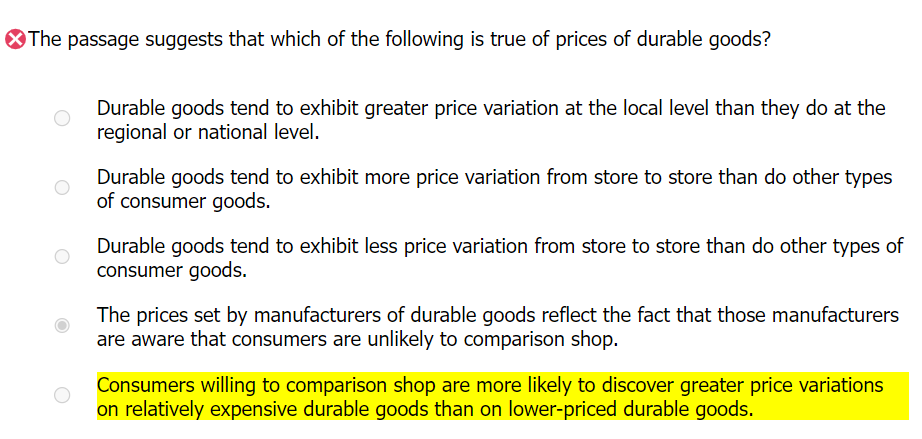
1.png [ 70.67 KiB | Viewed 10792 times ]
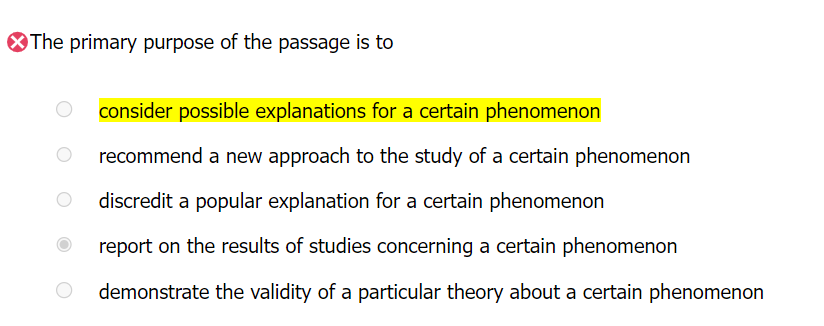
2.png [ 38.31 KiB | Viewed 10784 times ]
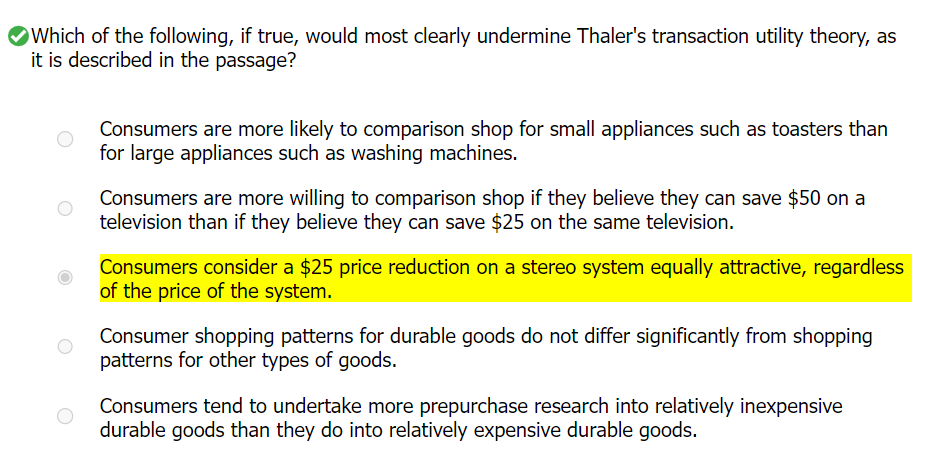
3.png [ 79.16 KiB | Viewed 10784 times ]
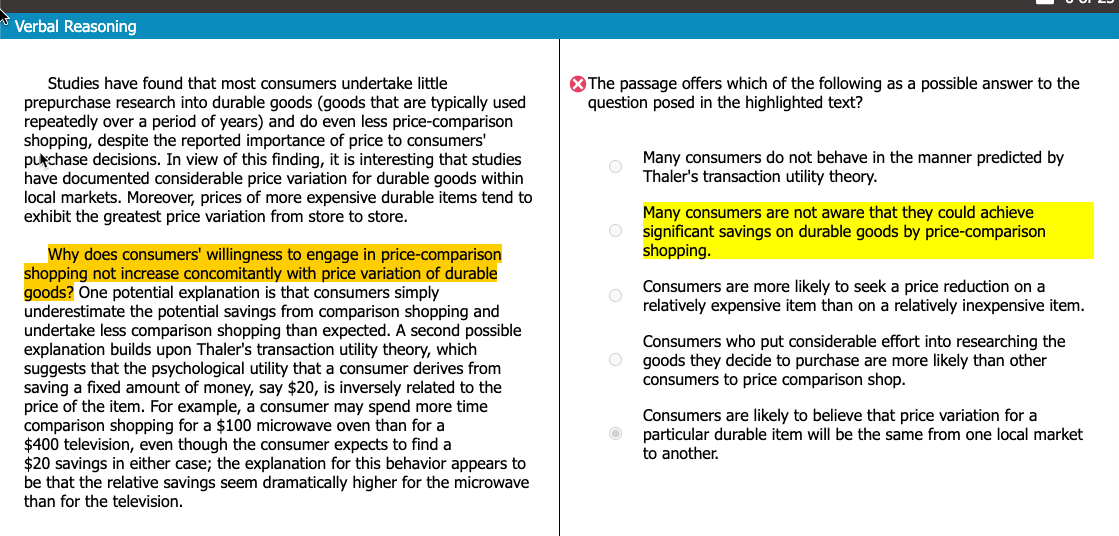

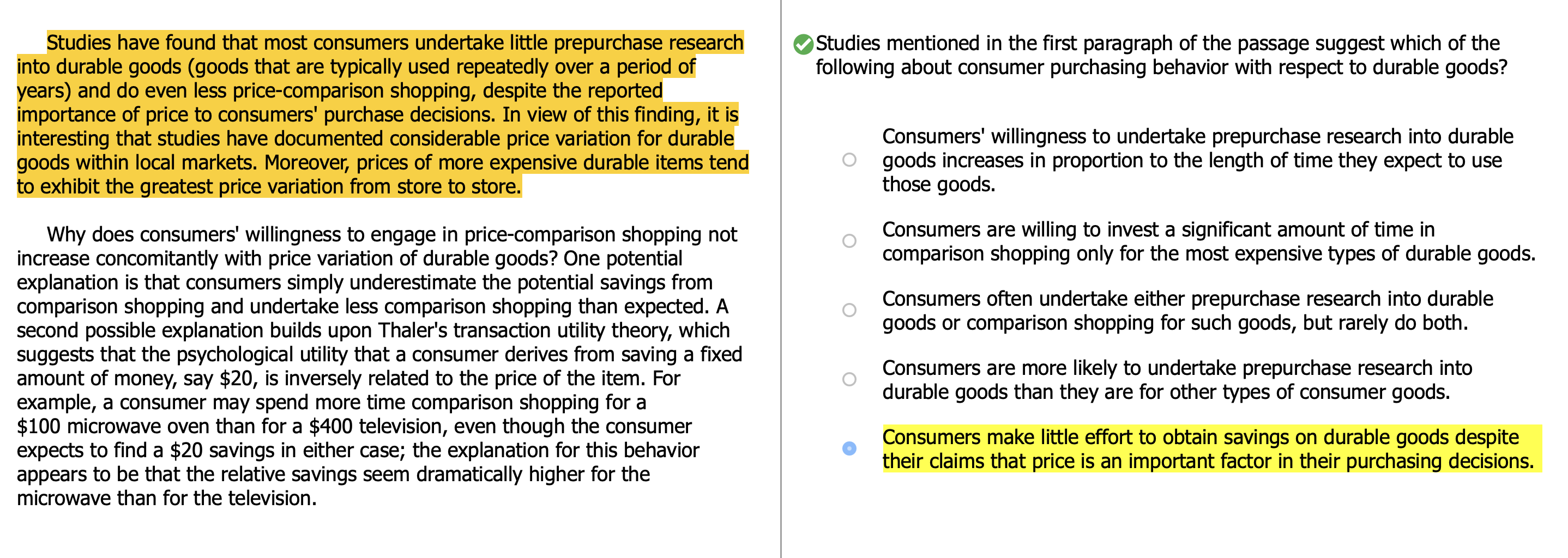
Attachment:
1.png [ 70.67 KiB | Viewed 10792 times ]
Attachment:
2.png [ 38.31 KiB | Viewed 10784 times ]
Attachment:
3.png [ 79.16 KiB | Viewed 10784 times ]
Kudos
Bookmarks
Studies have found that most consumers undertake little prepurchase research into durable goods (goods that are typically used repeatedly over a period of years) and do even less price- comparison shopping, despite the reported importance of price to consumers’ purchase decisions.
The customers, based on a research, miss two things fundamentally:
1) they do little research upfront before to buy durable goods (think about for example a smart tv)
2)they perform little to zero research to compare the prices of the same item even though this is quite important
In view of this finding, it is interesting that studies have documented considerable price variation for durable goods within local markets. Moreover, prices of more expensive durable items tend to exhibit the greatest price variation from store to store.
1) The consequence of the behavior above is two-fold: remarkable variations in the prices of the item we consider
2) From store to store the same item which is more expensive has a fluctuation in the price greater than a durable item which costs less
Why does consumers’ willingness to engage in price-comparison shopping not increase concomitantly with price variation of durable goods? One potential explanation is that consumers simply underestimate the potential savings from comparison shopping and undertake less comparison shopping than expected
1) why regardless the important findings above the customers still do not perform an important price comparison? On reason is that the same customers do not understand the potentiality of the price comparison
second possible explanation builds upon Thaler’s transaction utility theory, which suggests that the psychological utility that a consumer derives from saving a fixed amount of money, say $20, is inversely related to the price of the item.
Thaler's theory could explain that: consumers perceive more important to save for example 20 bucks for a durable item which costs overall not that much, suppose 100 dollars. However, if the durable good costs 1000 dollars the utility is perceived less
For example, a consumer may spend more time comparison shopping for a $100 microwave oven than for a $400 television, even though the consumer expects to find a $20 savings in either case; the explanation for this behavior appears to be that the relative savings seem dramatically higher for the microwave than for the television.
An example is also useful when we need to understand the utility between durable items.
The customers, based on a research, miss two things fundamentally:
1) they do little research upfront before to buy durable goods (think about for example a smart tv)
2)they perform little to zero research to compare the prices of the same item even though this is quite important
In view of this finding, it is interesting that studies have documented considerable price variation for durable goods within local markets. Moreover, prices of more expensive durable items tend to exhibit the greatest price variation from store to store.
1) The consequence of the behavior above is two-fold: remarkable variations in the prices of the item we consider
2) From store to store the same item which is more expensive has a fluctuation in the price greater than a durable item which costs less
Why does consumers’ willingness to engage in price-comparison shopping not increase concomitantly with price variation of durable goods? One potential explanation is that consumers simply underestimate the potential savings from comparison shopping and undertake less comparison shopping than expected
1) why regardless the important findings above the customers still do not perform an important price comparison? On reason is that the same customers do not understand the potentiality of the price comparison
second possible explanation builds upon Thaler’s transaction utility theory, which suggests that the psychological utility that a consumer derives from saving a fixed amount of money, say $20, is inversely related to the price of the item.
Thaler's theory could explain that: consumers perceive more important to save for example 20 bucks for a durable item which costs overall not that much, suppose 100 dollars. However, if the durable good costs 1000 dollars the utility is perceived less
For example, a consumer may spend more time comparison shopping for a $100 microwave oven than for a $400 television, even though the consumer expects to find a $20 savings in either case; the explanation for this behavior appears to be that the relative savings seem dramatically higher for the microwave than for the television.
An example is also useful when we need to understand the utility between durable items.
Kudos
Bookmarks
QUESTION #1
1. The passage suggests that which of the following is true of prices of durable goods?
A. Durable goods tend to exhibit greater price variation at the local level than they do at the regional or national level.
Not mentioned whatsoever in the passage the variation at different market level
B. Durable goods tend to exhibit more price variation from store to store than do other types of consumer goods.
No finding or info in the passage about the highlighted portion
C. Durable goods tend to exhibit less price variation from store to store than do other types of consumer goods.
No info about that
D. The prices set by manufacturers of durable goods reflect the fact that those manufacturers are aware that consumers are unlikely to comparison shop.
Not information about the manufacturers and what the know about consumers
E. Consumers willing to comparison shop are more likely to discover greater price variations on relatively expensive durable goods than on lower-priced durable goods.
Correct, It is a rephrasing of the last sentence in the first paragraph
1. The passage suggests that which of the following is true of prices of durable goods?
A. Durable goods tend to exhibit greater price variation at the local level than they do at the regional or national level.
Not mentioned whatsoever in the passage the variation at different market level
B. Durable goods tend to exhibit more price variation from store to store than do other types of consumer goods.
No finding or info in the passage about the highlighted portion
C. Durable goods tend to exhibit less price variation from store to store than do other types of consumer goods.
No info about that
D. The prices set by manufacturers of durable goods reflect the fact that those manufacturers are aware that consumers are unlikely to comparison shop.
Not information about the manufacturers and what the know about consumers
E. Consumers willing to comparison shop are more likely to discover greater price variations on relatively expensive durable goods than on lower-priced durable goods.
Correct, It is a rephrasing of the last sentence in the first paragraph












